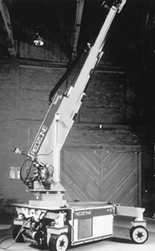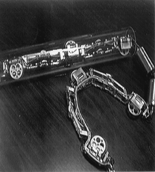
Spotlight on the focus areas
The focus areas have conducted, or are in the process of conducting, site needs assessments to ensure technology development efforts are focused on significant site problems. These assessments guide focus areas in their selection of proposals to meet specific needs at a site. Crosscutting programs participate by identifying strategies to satisfy site needs. To meet the
Office of Environmental Management's goal of an integrated technology program, the Office of Science and Technology focus areas coordinate with EM-30, EM-40, and EM-60 across the system in requests for, and review of, proposals.
Tanks
Hydraulic Testbed demonstrated -- On September 27, the tanks focus area hosted a working demonstration of the Hydraulic Testbed in the 337 High Bay at the Hanford Site near Richland, Washington. Salt cake and sludge simulants were retrieved using a high-pressure water jet scarifier. For salt cake, several passes were made over the simulated waste. During the sludge demonstration, kaolin sludge simulant was retrieved down to the tank bottom.
Over the past two fiscal years, the
U.S. Department of Energy, Pacific Northwest Laboratory, Westinghouse Hanford Company, Quest Integrated Inc., and the University of Missouri at Rolla have been working together to develop the Hydraulic Testbed where tank waste dislodging and conveyance tools will be tested and refined.
Users, industry representatives, and stakeholders attended the demonstration and toured the newly completed simulant laboratory. During the tour, equipment used for physical property analysis and a horizontal and inclined pneumatic conveyance line were demonstrated.
Light Duty Utility Arm video end effectors delivered to Hanford -- The Westinghouse Savannah River Company has completed and delivered to DOE's Hanford Site three video systems to be used as end-of-arm tools for the LDUA. (For more information about the LDUA, see Initiatives, Volume 2, April 1995.) The video systems include an Optical Alignment Scope, Still/Stereoscopic Photographic System, and a High Resolution Stereoscopic Video System. These systems will undergo testing and qualification before they are ready for use with the LDUA for remote inspection, surveillance, and characterization of tank wastes.
LDUA Internet homepage created -- The LDUA project has created an informational page on the Internet's World Wide Web. This page provides information about the LDUA project, including a list of contributors and sponsors with links to corresponding company homepages, short descriptive texts, graphics of various LDUA subsystems, and a list of LDUA published papers. The address is .
Mixed waste Technical baseline being developed -- The mixed waste focus area is building a technical baseline to direct program development. The first step was visiting major sites during the summer to discuss needs with customers -- representatives from EM-30, EM-40, and EM-60. The specific purposes of the site visits were to identify:
- technology development needs for managing mixed wastes;
- regulatory constraints;
- technology transfer and other privatization efforts;
- planned, ongoing, and completed technology development tasks;
- quick wins, i.e., potential matches between current capabilities and defined site technology needs.
The MWFA also analyzed proposed site treatment plans, the 1995 Report of Hanford Site Land Disposal Restrictions for Mixed Waste, and other applicable documents. Based on site visits and document reviews, a draft MWFA DOE Technology Needs Report was developed, which is being circulated to headquarters and field sites for review.
The next step has begun with the development of waste-specific treatment flowsheets. These flowsheets address identified needs in five mixed waste categories -- waste waters, combustible organics, sludges and soils, debris and solids, and unique wastes. A prioritization rationale and process, currently under review, will be used to decide which needs will be addressed first. Those technologies will form the MWFA's technical baseline.
Independent peer review sponsored -- The mixed waste and landfill stabilization focus areas sponsored an independent peer review of thermal treatment technologies. The reviewers met in Dallas, Texas during the week of November 13 to listen to principal investigators and to recommend future thermal treatment investments. The review panel assessed current and past technology developments dealing with transuranic, transuranic mixed, and low-level mixed waste. The review recommendations will be used to develop a clear path forward for future development work.
Landfill stabilization
Landfill covers to be demonstrated -- The landfill stabilization focus area is sponsoring a large-scale alternative landfill cover demonstration. See the related article on this demonstration being conducted by
Sandia National Laboratories.
Plumes
Organic product line to expand -- In 1996, the contaminant plumes containment and remediation focus area will continue to build its organic product line -- technologies with demonstrated capability to remediate hazardous organic contaminants. Over the past four years, technologies such as air sparging using horizontal wells, in-situ bioremediation of trichloroethylene, and off-gas treatment of volatile organics have expanded the organic product line. The plumes focus area organic product line will be completing demonstrations and technology transfer of several major remediation systems in 1996. These include ResonantSonic drilling, in-well vapor stripping (as part of a joint U.S. Department of Energy/
U.S. Department of Defense effort), and in-situ anaerobic bioremediation.
Decontamination & decommissioning
Three DOE facilities selected to host large-scale D&D technologies --The
Morgantown Energy Technology Center received eight proposals from DOE operations offices in response to METC's solicitation seeking sites for large-scale D&D demonstrations. The eight proposals were evaluated by a review team representing EM-30, EM-40, EM-60, METC, and the Army Corps of Engineers. On October 10, three DOE facilities were selected to serve as host facilities to demonstrate innovative decontamination and decommissioning technologies. The three selected projects and associated facilities are decommissioning the Chicago Pile 5 test reactor at Argonne-East; decommissioning the Plant 1 complex at Fernald, Ohio; and deactivating the C-reactor at Hanford in Richland, Washington.
These large-scale demonstration projects are the cornerstone of the D&D focus area's strategy to move D&D technologies from development to implementation. These projects will demonstrate the benefits of using a combination of commercial and innovative technologies to deactivate or decommission facilities that are owned by EM-40 and EM-60. Each of the large-scale demonstration projects will be managed and conducted by an integrating contractor team that will be able to use its experience and expertise to perform D&D projects at other DOE facilities.
Robotics technology
Robots demonstrate D&D capabilities -- On September 19, the Robotics Technology Development Program demonstrated robotic and remote handling systems being developed for the Decontamination and Dismantlement Robotics Program. These demonstrations were held in the Robotics Technology Assessment Facility at Oak Ridge National Laboratory. Three characterization systems and two dismantlement systems were featured in the demonstration attended by approximately 60 people, including representatives from DOE headquarters and field offices, site contractors, and stakeholders. DOE site development teams, and university and industry developers helped support the demonstrations.
A stakeholder expresses his viewpoint -- Don Kawal, a member of the Community Leaders Network, attended the demonstration and later wrote in his trip report, "It was rewarding to see equipment that was practical and productive for decontamination and dismantlement, much of which could be in use within a year." Among the D&D systems which he saw and reported on were a Small Pipe Characterization robot and the Rosie Remote Work System.
"The Small Pipe Characterization robot, developed by the Idaho National Engineering Laboratory, is a one-of-a-kind prototype and needs some refinements before being practical. It may be available within two or three years." The system was operated in clear plastic piping to demonstrate pipe traverse, including travel through elbows and tees, as well as movement between various pipe diameter sizes.
 The Rosie Remote Work System was demonstrated as a mobile platform from which various robotic attachments can be added to accomplish different tasks. From a radiation-free environment, the operator can remotely manipulate both the mobile platform and the attachments to complete work in a hazardous environment. During the demonstration, an operator remotely controlled a concrete breaker tool mounted on the Rosie vehicle.
The Rosie Remote Work System was demonstrated as a mobile platform from which various robotic attachments can be added to accomplish different tasks. From a radiation-free environment, the operator can remotely manipulate both the mobile platform and the attachments to complete work in a hazardous environment. During the demonstration, an operator remotely controlled a concrete breaker tool mounted on the Rosie vehicle.
Characterization, monitoring, and sensor technology
CMST involves private sector and national laboratories -- As a support contractor for the CMST,
Ames Laboratory will assess the capabilities of commercially available analytical tools to meet DOE needs. As a part of this project, Ames issued a solicitation seeking firms to conduct a marketing survey to determine what is currently being used for environmental analysis in the field and for what applications. Other information sought is the existing customers for this type of instrumentation, as well as how the market and customer base might expand given both existing and developing instrumentation technologies. Awards were announced in late November.
 CMST and the tanks focus area are jointly funding five projects from national laboratories addressing in-situ tank waste sampling, characterization, retrieval, process monitoring, and storage. The five national laboratories are Pacific Northwest Laboratory, Sandia National Laboratories, Lawrence Livermore National Laboratory, Sandia National Laboratory Livermore, and Argonne National Laboratory.
CMST and the tanks focus area are jointly funding five projects from national laboratories addressing in-situ tank waste sampling, characterization, retrieval, process monitoring, and storage. The five national laboratories are Pacific Northwest Laboratory, Sandia National Laboratories, Lawrence Livermore National Laboratory, Sandia National Laboratory Livermore, and Argonne National Laboratory.
Capabilities of technologies to detect heavy metals will be validated by EPA -- On September 26, CMST participated in a heavy-metals-in-soils demonstration held at DOE's Western Environmental Technology Office in Butte, Montana. WETO provided a test bed and logistics. During the event, soil samples were prepared and analyzed by four field deployable methods. Later, the U.S. Environmental Protection Agency evaluated the capabilities of the four technologies to detect and quantify heavy metals in soils. An EPA-certified laboratory performed confirmatory analyses of field samples taken during the demonstration. EPA will issue a written report and a letter of verification to qualifying technologies. EPA's involvement in this demonstration will accelerate the acceptance and use of cost-effective technologies.
Efficient separations and processing technology
Scope of ESP defined -- The efficient separations and processing crosscutting program (ESP) provides innovative chemical and physical separation technologies that decrease the cost, duration, and risk associated with the remediation of DOE waste sites. The ESP crosscutting program develops technologies for the separation of specific pollutants from the waste stream. Since the specific component of the waste that is of regulatory, health, or safety concern may only be a small fraction of the whole waste, successful separation can potentially reduce cleanup costs and health and environmental risks.
Technical information exchange meeting scheduled -- Each January ESP holds a technical information exchange meeting in Gaithersburg, Maryland for principal investigators in the program. The emphasis at this meeting is to disseminate information on various projects among other investigators funded by the program, members of the focus areas, and other interested individuals. This year the technical information exchange meeting will include presentations from eight 1995 Small Business Innovation Research award winners who are now associated with ESP. The meeting is held on an invitation basis. For more information, please call Ian Tasker of Waste Policy Institute at (301) 990-3001.





 The Rosie Remote Work System was demonstrated as a mobile platform from which various robotic attachments can be added to accomplish different tasks. From a radiation-free environment, the operator can remotely manipulate both the mobile platform and the attachments to complete work in a hazardous environment. During the demonstration, an operator remotely controlled a concrete breaker tool mounted on the Rosie vehicle.
The Rosie Remote Work System was demonstrated as a mobile platform from which various robotic attachments can be added to accomplish different tasks. From a radiation-free environment, the operator can remotely manipulate both the mobile platform and the attachments to complete work in a hazardous environment. During the demonstration, an operator remotely controlled a concrete breaker tool mounted on the Rosie vehicle.

